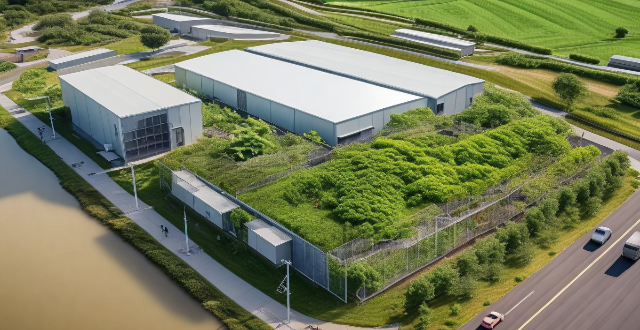This article outlines key strategies for reducing climate loss and damage, including transitioning to renewable energy sources, improving energy efficiency, promoting afforestation and reforestation, adopting sustainable agriculture practices, reducing waste and increasing recycling efforts, exploring carbon capture and storage technologies, and fostering international cooperation and policy initiatives.

Introduction
Climate change is one of the most pressing issues facing humanity today. It has far-reaching consequences, including rising sea levels, more frequent and severe weather events, loss of biodiversity, and food insecurity. To mitigate these impacts, it is crucial to adopt effective strategies for reducing climate loss and damage. In this article, we will explore some of the most effective strategies for achieving this goal.
Key Strategies for Reducing Climate Loss and Damage
1. Transition to Renewable Energy Sources
The transition to renewable energy sources is perhaps the most important strategy for reducing climate loss and damage. Fossil fuels are a major source of greenhouse gas emissions, which contribute significantly to global warming. By shifting to renewable energy sources such as solar, wind, hydroelectric, and geothermal power, we can significantly reduce our carbon footprint and minimize the impact of climate change.
Benefits of Renewable Energy:
* Reduced Emissions: Renewable energy sources produce little to no greenhouse gas emissions during operation.
* Sustainability: These resources are replenished naturally and do not deplete finite resources like fossil fuels.
* Economic Benefits: Investing in renewable energy can create jobs, stimulate economic growth, and reduce dependence on imported fossil fuels.
2. Energy Efficiency Measures
Improving energy efficiency is another key strategy for reducing climate loss and damage. This involves using less energy to perform the same tasks or achieving higher performance with the same amount of energy.
Ways to Improve Energy Efficiency:
* Building Design: Incorporate energy-efficient designs in buildings, such as better insulation, efficient windows, and smart HVAC systems.
* Transportation: Encourage the use of public transportation, carpooling, cycling, and walking to reduce emissions from transportation.
* Industrial Processes: Optimize industrial processes to reduce energy consumption and waste generation.
3. Afforestation and Reforestation
Trees absorb CO2 from the atmosphere during photosynthesis, making afforestation (establishing new forests) and reforestation (re-establishing forests in areas where they have been cut down or degraded) effective strategies for reducing climate loss and damage.
Benefits of Afforestation and Reforestation:
* Carbon Sequestration: Trees absorb and store carbon dioxide, reducing the amount of this greenhouse gas in the atmosphere.
* Biodiversity: Forests provide habitat for countless species of plants and animals, helping to preserve biodiversity.
* Soil Protection: Trees help prevent soil erosion and maintain water quality by filtering pollutants.
4. Sustainable Agriculture Practices
Agriculture is a significant contributor to greenhouse gas emissions, particularly through practices like deforestation for cropland and livestock farming. Adopting sustainable agriculture practices can help reduce these emissions and protect natural ecosystems.
Sustainable Agriculture Practices Include:
* Conservation Tillage: Minimizing soil disturbance to reduce erosion and improve soil health.
* Integrated Pest Management: Using natural predators and other non-chemical methods to control pests.
* Cover Crops: Planting crops that protect and enrich the soil when main crops are not growing.
5. Waste Reduction and Recycling
Reducing waste and increasing recycling efforts can help minimize the environmental impact of consumer goods and industrial processes. This includes both reducing the amount of waste generated and finding ways to reuse or recycle materials that would otherwise end up in landfills or oceans.
Waste Reduction Strategies:
* Reduce: Consume less by choosing durable products and avoiding single-use items.
* Reuse: Find new uses for old items instead of discarding them.
* Recycle: Properly sort and recycle materials like paper, plastic, glass, and metal.
6. Carbon Capture and Storage (CCS)
Carbon capture and storage technologies aim to capture CO2 emissions from power plants and industrial processes before they are released into the atmosphere. The captured CO2 is then stored underground in geological formations.
Benefits of CCS:
* Direct Emission Reduction: Allows for the continued use of fossil fuels while minimizing their environmental impact.
* Potential for Negative Emissions: When combined with bioenergy, CCS can result in net removal of CO2 from the atmosphere.
7. International Cooperation and Policy Initiatives
Addressing climate change requires global cooperation and coordinated policy initiatives. This includes agreements like the Paris Agreement, which aims to limit global warming to well below 2°C above pre-industrial levels and pursue efforts to limit the temperature increase to 1.5°C.
Key Components of International Cooperation:
* Shared Responsibility: Recognize that all nations have a role to play in addressing climate change.
* Financial and Technological Support: Developed countries should provide financial and technological support to help developing countries adopt cleaner technologies and adapt to climate change impacts.
* Transparency and Accountability: Countries should regularly report their emissions and progress towards climate goals to ensure transparency and accountability.
Conclusion
Reducing climate loss and damage requires a multifaceted approach that encompasses transitioning to renewable energy sources, improving energy efficiency, promoting afforestation and reforestation, adopting sustainable agriculture practices, reducing waste and increasing recycling efforts, exploring carbon capture and storage technologies, and fostering international cooperation and policy initiatives. By implementing these strategies collectively, we can make significant strides towards mitigating the impacts of climate change and protecting our planet for future generations.